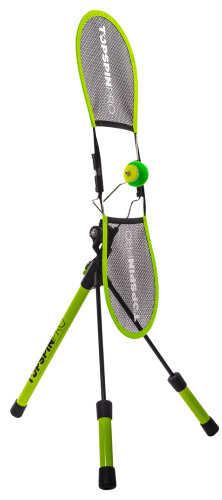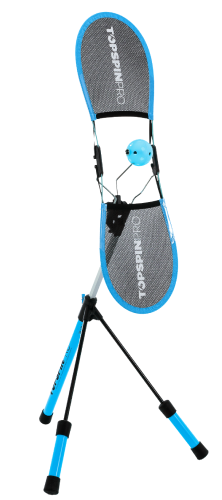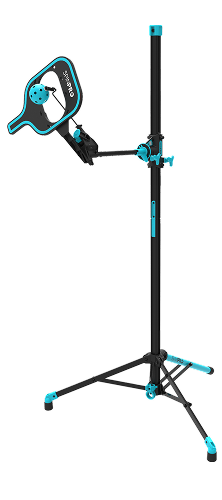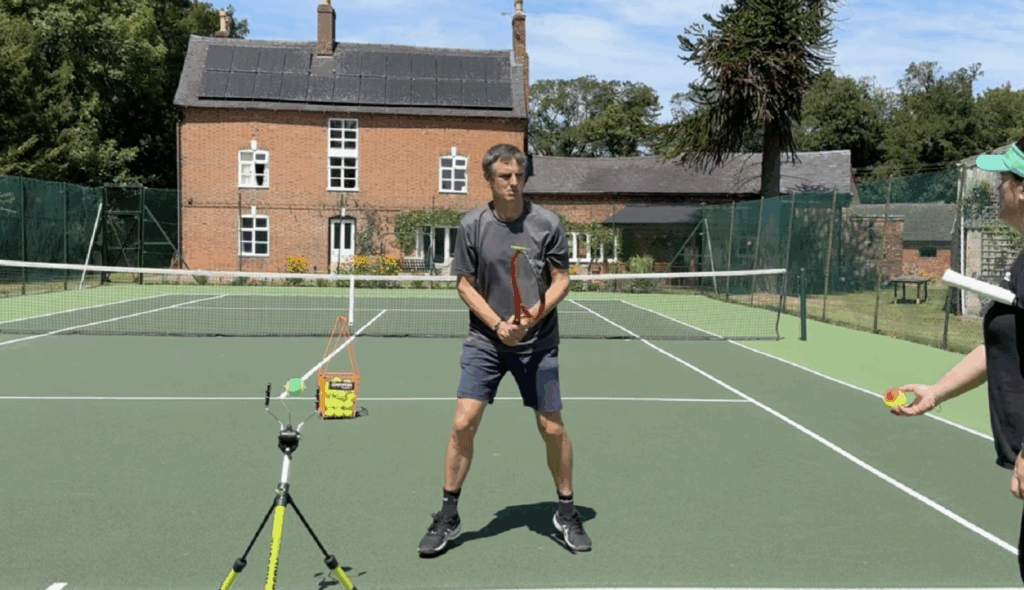As coaches, our goal is to help players improve and master their skills without unnecessary bumps in the road. Yet many beginners lose confidence and often quit before they’ve had a chance to succeed. The key to keeping them engaged is building confidence and having them see success early on so they are not put off the game right at the start. The most effective way to do that is through structured progressions.
Progressions allow players to advance at a pace tailored to them, without being overloaded physically or mentally. By splitting skills into stages with gradually increasing levels of difficulty, it means players can move on at a pace that is right for them and that they are ready for.
Too often, experienced coaches forget what it feels like to be a beginner. Tennis has so many moving parts like footwork, spacing, contact point and swing shape, that it can instantly feel overwhelming. By following progressions, you simplify the learning process. Each step builds on the last, keeping students comfortable while still moving forward.
Our guide, How to Improve Tennis Fast, provides tips for players, but here’s how to bring it into your own coaching:
Why Use Progressions?
Guiding players through step-by-step progressions provides significant advantages. Instead of being overwhelmed by the full complexity of tennis, players can focus on one element at a time.
When working on technique, it’s important to begin with the foundation, the Contact Point. The contact point is the most important part of every shot. Without that, the ball will not go where you want. Once you have established muscle memory for a good contact you can build out the swing shape. This approach builds a strong technical foundation while also reducing frustration. It enables early success and makes learning feel more achievable. Each small stage is a win before moving on to the next.
For a coach, progressions also create a clear framework for lessons, ensuring players get the right number of repetitions at the right intensity without skipping critical stages. Over time, this structured path not only accelerates improvement but also helps players transfer skills more naturally into rallies and competitive matches.
There are a few other reasons why a gradual progression approach leads to better results:
- Volume: Isolating one skill allows reps of high quality technique. By zoning in on this one skill, it can be repeated a high number of times, which allows for the formation of muscle memory.
- Reduced Pressure: Players learn without the distraction of outcome pressure, so they can ingrain proper mechanics. This allows for the formation of correct technique without any bad habits caused by pressure of where the ball is landing.
- Technique Awareness: In controlled drills, players focus on form rather than whether the ball lands in or wins the point. Players build awareness of their technique faster.
The 6-Step Progression Roadmap
Before we look at the 6 main progressions there's a couple of things to think about when choosing what to work on with your student:
Focus On One Skill
One of the biggest reasons coaches stall with their players’ improvement is because they spread their attention too thin. In a single practice session, they might try to refine their student’s backhand, adjust their serve stance, and work on court positioning. Or they’ll mix technical changes with tactical play, such as working on forehand mechanics during approach-shot drills. The result? Their brain gets overloaded and nothing sticks. Plus they don't get enough reps of one skill to have it improve.
Learning is far more effective when you isolate one area at a time. Maybe it’s the spacing of the contact point, backswing or a specific footwork adjustment. By narrowing your focus, you allow the student’s nervous system to create stronger, longer-lasting connections. That’s what turns a new skill into a habit.
In short: pick one skill, commit to it, and have the student master it before moving on.
Understand the Correct Technique
Before you dive into working on a new skill with your student, take the time to make sure you truly understand it yourself, not just how it looks when performed correctly, but also the underlying mechanics that make it work. As a coach, your role is to translate a complex movement into its simplest, most digestible parts. If you can’t break it down into clear, actionable steps, your players are more likely to feel overwhelmed or confused.
Once you’ve identified the core elements, whether that’s grip, swing path, footwork, or contact point, start with the part that needs improving and break it down to it's most simple form. When working on technique, this is usually the contact point. From there, you can begin to layer in complexity gradually: adding in more components of the swing, a moving ball, increasing speed, introducing decision-making, or simulating match pressure.
The key is progression. By starting simple and only increasing the challenge once a student shows comfort and consistency, you set them up for long-term success. This structured approach prevents bad habits, reduces frustration, and builds confidence at every stage of learning.
See below for the best progressions to move your student forward:
Progression 1: Isolate the Skill
Use static ball training aids like the TopspinPro or simple shadow swings to isolate the movement and take away distractions. This allows players to focus purely on the mechanics without worrying about where the ball goes. Practice slowly and deliberately so the body can memorize the correct shape. At this stage, it’s not about power or speed, it’s about accuracy and consistency. Aim for plenty of high-quality repetitions here, because this is where the foundation of the skill is built. The stronger the foundation, the easier it will be to add speed, variety, and pressure later on.
Here's an example of progressions for the backhand slice from TopspinPro to court:

Progression 2: Drop Feed Drills
Once the player is comfortable with the isolated movement, introduce a simple drop feed. This is the easiest way to help them start timing a moving ball while still keeping the pressure to a minimum. By dropping the ball from just above contact height, you remove the unpredictability of speed, spin, or direction. The student can focus on meeting the ball cleanly with the correct technique they’ve been rehearsing.
This step bridges the gap between static practice (like shadow swings or training aids) and the pressure of an incoming ball. It gets them used to the feeling of hitting a ball and how it feels on the strings with simple timing. It gives players an early sense of success while reinforcing confidence.
Progression 3: Moving Ball Drills
Once your player has mastered drop feeds, the next step is to progress to moving ball drills. This stage introduces a more realistic incoming ball and bounce, helping them apply their technique with a little added pressure.
Start with easy feeds directly into their strike zone so they can groove the motion without having to think about footwork. As they become more comfortable and consistent, gradually increase the challenge. Vary the speed, move them around, add a little depth, or require them to adjust their footwork to meet the ball. Finally, you can incorporate directional feeds that force them to recover, reposition, and hit again.
The key here is to raise the difficulty slowly, always keeping it just hard enough to stretch their ability without overwhelming them. These drills are essential for developing timing, spacing, and rhythm, the bridge between isolated technique and live rallying.
Compression balls can help with adult players as well as juniors. Check out the following video for some tips on using them with your progressions:

Progression 4: Rallies
Once players are comfortable with moving ball drills, it’s time to introduce rallies. This is where the skill begins to feel like real tennis. Start with simple cooperative rallies, such as from the service line, where both players keep the ball in play with controlled pace and height. The shorter court reduces pressure and makes success more likely. This is where compression balls can really help and keep your student successful.
As consistency improves, gradually extend the rally to the baseline and add targets or directional goals. Encourage players to focus on maintaining the technique they developed in the earlier steps. Rallies provide the perfect environment to blend technique with timing and footwork. They also build rhythm, confidence, and the ability to sustain quality shots under longer exchanges, key qualities for transitioning to competitive play.
Progression 5: Practice Points
After players have built consistency through rallies, the next step is to add a competitive element with practice points. These aren’t full matches yet, but structured scenarios that simulate point play while keeping a specific focus. For example, play out points in half a court but only use forehands. You can also condition the scoring, such as starting at 0–30 or awarding double points for winning with certain shot. This creates pressure by adding in a goal without overwhelming the player.
Practice points give students the chance to apply their technique under realistic conditions, bridging the gap between cooperative drills and true match play. They learn how to make decisions, manage nerves, and stay disciplined with their technique while competing for points. You can increase the level of pressure in practice points as they get nearer to real match play.
Progression 6: Match Play
The final stage of progression is match play, where players bring all their training into a real competitive environment. Encourage them to enter matches with one or two specific goals related to the skill they’ve been working on, rather than focusing solely on winning. For example, they might commit to hitting with topspin on every forehand or keeping a consistent depth beyond the service line.
Afterward, use reflection sessions to review how well they applied the skill and identify areas to reinforce in the next practice. Match play is where learning gets tested, but also where confidence grows the most. Players see their training translate into real results, which reinforces their belief in the process and motivates them to keep improving.
Why This Approach Works So Quickly
The power of progressions lies in how the brain and body learn new skills. When players zoom in on just one element at a time, the nervous system can create strong, lasting neural pathways. This is what transforms a new movement from something that feels awkward into something automatic.
By layering on difficulty in gradual steps, from isolated practice, to feeds, to rallies, to competitive pressure, players never feel overwhelmed, and their technique doesn’t fall apart under stress. The result is faster learning, stronger confidence, and more reliable shot-making in real match situations.
Coaches: How To Put This Into Practice
Structure your lessons with clear steps. Break each skill down into smaller stages and move forward only when the player shows comfort and consistency.
- Don't Rush: Don’t rush the process, one skill could last several weeks-months to master.
- Go Back A Step If Needed: Be ready to step back. For example, if a student struggles in rallies or match play, return to an earlier stage where they can succeed, then rebuild from there. This prevents frustration and reinforces confidence.
- Use Training Aids: Use tools for feedback. Training aids like the TopspinPro, or simple video analysis on a phone, give players immediate visual and physical feedback so they can connect what they feel with what they see.
- Set Goals: Set small achievable goals (this can be your progressions). Make sure the student understands the process and what they are trying to achieve. Celebrate small wins. Each successful step in a progression builds momentum, recognize and highlight these moments so players stay motivated.
By adopting a progression-based approach, coaches create a learning environment where players improve faster, avoid burnout, and build the kind of confidence that transfers directly into match play. By teaching smart progressions, you’re building stronger, more consistent players and saving valuable coaching time along the way. It also keeps students coming back!
Coach With Confidence Course
If you’d like a little extra guidance on how to use the TopspinPro to teach all the major shots in tennis, we also offer a guided video course. In it, our coaches walk you step-by-step through each stroke, showing you exactly how to incorporate the TopspinPro into your lessons so your players progress faster and with more confidence.
Find our more: Coach With Confidence: Developing Core Tennis Skills With The TopspinPro
Conclusion
Progressions aren’t just a teaching method, they’re a coaching philosophy. By breaking skills down into smaller, achievable steps, you create an environment where players learn efficiently, build confidence, and see results that stick. Whether it’s isolating technique on a training aid, working through controlled feeds, or testing skills in match play, each stage serves as a building block toward long-term success.
As a coach, your job is to guide that journey, knowing when to push forward, when to pause, and when to revisit the basics. When you apply progressions consistently, you’ll notice players not only improve faster but also enjoy the process more. And that’s what keeps them motivated, engaged, and on the court for the long haul.
So in your next lesson, try structuring the skill in clear steps, celebrate the small wins, and watch your players grow in both ability and confidence.
FAQs
-
Why are progressions important in tennis coaching?
Progressions help players focus on one skill at a time, reducing overwhelm and building a strong technical foundation. This step-by-step approach leads to early success, less frustration, and faster learning.
-
What is the first step in the 6-step progression roadmap?
The first step is to focus on one skill and master it before moving on. Isolating a single element allows the player’s nervous system to form lasting habits and makes improvement more reliable.
-
How do coaches ensure players learn the correct technique?
Coaches must fully understand the skill themselves, breaking it down into simple parts. Starting with basics like the contact point, they gradually add complexity only when the player shows comfort and consistency.
-
How do progressions help players transition to real match play?
Progressions move players from isolated practice to drop feeds, moving ball drills, rallies, and practice points before full matches. This gradual increase in challenge builds confidence and skill without overwhelming the player.
-
What should coaches do if a player struggles during rallies or match play?
Coaches should step back to an earlier progression stage where the player can succeed, then rebuild from there. This prevents frustration, reinforces confidence, and ensures steady progress.
Enjoyed this article?
Be sure to sign up for our newsletter and we'll keep you up to date about new posts



